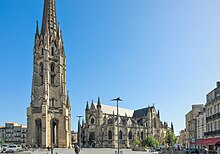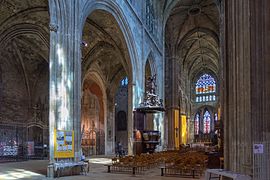
Bordeaux is a port city on the river Garonne in the Gironde department, Southwestern France. It is the capital of the Nouvelle-Aquitaine region, as well as the prefecture of the Gironde department. Its inhabitants are called "Bordelais" (masculine) or "Bordelaises" (feminine). The term "Bordelais" may also refer to the city and its surrounding region.

A mummy is a dead human or an animal whose soft tissues and organs have been preserved by either intentional or accidental exposure to chemicals, extreme cold, very low humidity, or lack of air, so that the recovered body does not decay further if kept in cool and dry conditions. Some authorities restrict the use of the term to bodies deliberately embalmed with chemicals, but the use of the word to cover accidentally desiccated bodies goes back to at least 1615 AD.

The Basilica of Saint-Denis is a large former medieval abbey church and present cathedral in the commune of Saint-Denis, a northern suburb of Paris. The building is of singular importance historically and architecturally as its choir, completed in 1144, is widely considered the first structure to employ all of the elements of Gothic architecture.

The Basilica of Sacré Coeur de Montmartre, commonly known as Sacré-Cœur Basilica and often simply Sacré-Cœur, is a Roman Catholic church and minor basilica in Paris, France, dedicated to the Sacred Heart of Jesus.

Saint Patrick's Basilica is a Roman Catholic minor basilica on René-Lévesque Boulevard in Downtown Montreal, Quebec, Canada.
Saintes is a commune and historic town in western France, in the Charente-Maritime department of which it is a sub-prefecture, in Nouvelle-Aquitaine. Its inhabitants are called Saintaises and Saintais. Saintes is the second-largest city in Charente-Maritime, with 26,470 inhabitants in 2008. The city's immediate surroundings form the second-most populous metropolitan area in the department, with 56,598 inhabitants. While a majority of the surrounding landscape consists of fertile, productive fields, a significant minority of the region remains forested, its natural state.
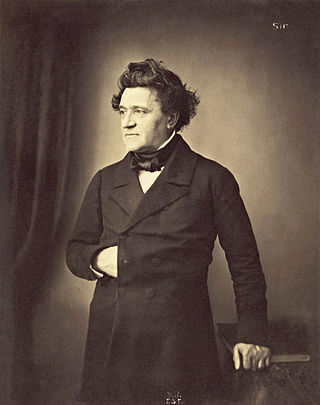
Paul Abadie was a French architect and building restorer. He is considered a central representative of French historicism. He was the son of architect Paul Abadie Sr.

The Basilica of Saint-Sernin is a church in Toulouse, France, the former abbey church of the Abbey of Saint-Sernin or St Saturnin. Apart from the church, none of the abbey buildings remain. The current church is located on the site of a previous basilica of the 4th century which contained the body of Saint Saturnin or Sernin, the first bishop of Toulouse in c. 250. Constructed in the Romanesque style between about 1080 and 1120, with construction continuing thereafter, Saint-Sernin is the largest remaining Romanesque building in Europe. The church is particularly noted for the quality and quantity of its Romanesque sculpture. In 1998 the basilica was added to the UNESCO World Heritage Sites under the description: World Heritage Sites of the Routes of Santiago de Compostela in France.

The Basilica of Notre-Dame de Fourvière is a minor basilica in Lyon, France. It was built with private funds between 1872 and 1896 in a dominant position overlooking the city. The site it occupies was once the Roman forum of Trajan, the forum vetus, thus its name.

The Basilica of Saints Nazarius and Celsus is a Roman Catholic minor basilica located in the citadel of Carcassonne, France. It is a national monument, and is in the Gothic-Romanesque architectural tradition.

The Guadalajara Cathedral or Cathedral of the Assumption of Our Lady, located in Centro, Guadalajara, Jalisco, is the Roman Catholic cathedral of the Archdiocese of Guadalajara and a minor basilica. It is built in the Spanish Renaissance style, except its neo-Gothic spires.

St. George's Basilica is the oldest surviving church building within Prague Castle, Prague, Czech Republic. The basilica was founded by Vratislaus I of Bohemia in 920. It is dedicated to Saint George. Primarily Romanesque in style, it is part of the collection of buildings that comprise the castle, the political capital of the nation, and the spiritual center of the Czech state.

The metropolitan city of Kraków, former capital of Poland, is known as the city of churches. The abundance of landmark, historic Roman Catholic churches along with the plenitude of monasteries and convents earned the city a countrywide reputation as the "Northern Rome" in the past. The churches of Kraków comprise over 120 Roman Catholic places of worship, of which over 60 were built in the 20th century. They remain the centers of religious life for the local population and are attended regularly, while some are often crowded on Sundays.
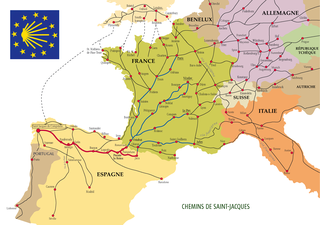
UNESCO designated the Routes of Santiago de Compostela in France as a World Heritage Site in December 1998. The routes pass through the following regions of France: Aquitaine, Auvergne, Basse-Normandie, Bourgogne, Centre, Champagne-Ardenne, Ile-de-France, Languedoc-Roussillon, Limousin, Midi-Pyrénées, Picardie, Poitou-Charentes, and Provence-Alpes-Côte d'Azur. UNESCO cites the routes' role in "religious and cultural exchange", the development of "specialized edifices" along the routes, and their "exceptional witness to the power and influence of Christian faith among people of all classes and countries in Europe during the Middle Ages".

Basilica of St. Donatian and St. Rogatian is a Roman Catholic minor basilica in Nantes, France. The church was built in the late 19th century and is dedicated to saints Donatian and Rogatian. It was elevated to the rank of minor basilica in 1889.

The Basilica of Saint-Quentin, formerly the Collegiate Church of Saint-Quentin is a Catholic church in the town of Saint-Quentin, Aisne, France. There have been religious buildings on the site since the 4th century AD, which were repeatedly destroyed and rebuilt during the Early Middle Ages. The present basilica was constructed in stages between the 12th and 15th centuries. It was severely damaged in World War I (1914–18), and was only reopened in 1956 after extensive reconstruction.
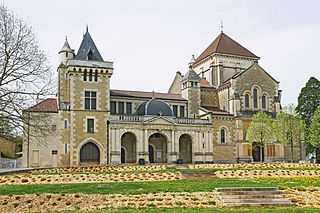
The Couvent et Basilique Saint-Bernard is a group of buildings in Fontaine-lès-Dijon, France, including a convent, basilica and church set in a public park. The complex contains the birthplace of Saint Bernard of Clairvaux (1090–1153), the main reformer of the Cistercians. The present buildings date no further back than the Late Middle Ages, and have been greatly modified since then, with a major renovation in the late 19th century.

The Basilique Notre Dame du Bon Secours, Marie Auxiliatrice is a Gothic Revival basilica in Bonsecours near Rouen, Seine-Maritime, France. It is the first church in France to be built in the Gothic Revival style. The church is richly decorated, with the windows, sculptures and other elements often carrying the name or coat of arms of a donor.

The Basilica of Saint Severinus is a church built in Bordeaux at the dawn of the 11th century.

The Basilica of Saint-Remi is a medieval abbey church in Reims, France. It was founded in the 11th century "over the chapel of St. Christophe where St. Remi was buried." It is "the largest Romanesque church in northern France, though with later additions." The church has been a monument historique since 1840, and a UNESCO World Heritage Site since 1991 as a part of Cathedral of Notre-Dame, former Abbey of Saint-Remi and Palace of Tau.
